Toolkit contents
Set Up
Identify a coordinator
Select a site
Set a date & time
Recruit volunteers
Prepare supplies
Clean Up
Meet at site
Pick up litter
Regroup & record data
Debrief & dispose of litter
Talk It Up
Report & share your cleanup
Additional Resources
Glossary
Volunteer signup
Sample flyer
If you are organizing your own cleanup, this section is especially for you!
Please note that this phase of the project can take a while as it requires ample planning and decision-making.
If you are joining a cleanup, you may wish to skip ahead to the Clean up and Talk it up sections of this toolkit to understand what a cleanup entails.
1. IDENTIFY A COORDINATOR
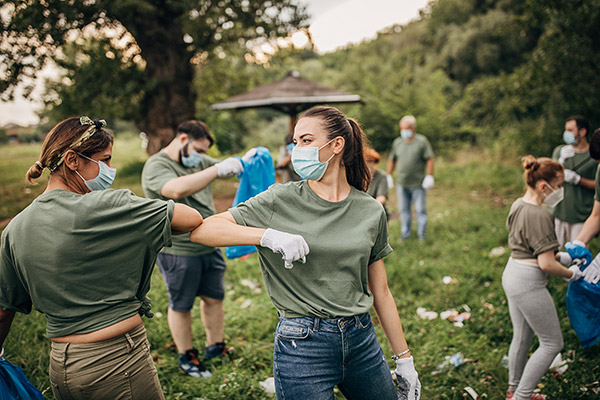
There are no special qualifications needed to be a cleanup coordinator. If you are willing and able to commit to the role, you can skip forward to the next step (Recruit volunteers). If you are in need of a coordinator, here are some ways to find one. A cleanup can be coordinated by two people, as well!
- Share your cleanup in a social media post
- Run an ad for your cleanup through your local newspaper
- Post a flyer at a community bulletin board (template available)
- Distribute door hangers around your neighborhood (template available)
- Recruit at your workplace or in your community group
- Invite friends, family, and neighbors
A coordinator manages the cleanup from beginning to end, is responsible for the safety and cooperation of volunteers, and may also need to report or post details about the cleanup.
2. SELECT A SITE

Keep in mind, these tips do not apply to every possible site and situation. Every site is unique, so use our advice as much as it is useful to your specific situation.
In general, a small and manageable section of shoreline is better for a cleanup than a large and ambitious one.
Not sure where to go? Consider asking your city/township, watershed district, soil and water conservation district, parks and recreation department, or a nearby lake association for ideas. They often know places where trash collects.
Consider the size of your volunteer group and the density of litter in the area, and use your best judgement in determining a site. If you can visit the potential site before making it official, you will have a better idea of its "carrying capacity" and you can establish site boundaries (the length of shoreline you want cleaned and the landmarks that indicate that distance).
![]() Anything you can clean up helps, but volunteers will probably feel more accomplished if the site is small (proportionate to the size of the group) and progress can be observed easily.
Anything you can clean up helps, but volunteers will probably feel more accomplished if the site is small (proportionate to the size of the group) and progress can be observed easily.
WHAT TO LOOK FOR IN A SITE
- Easily accessible to volunteers
- Free public parking (lot or street) within ½ mile of intended site
- Near a transit stop or station (for metro cleanups)
- Dumpster or waste & recycling collection available (if you cannot haul)
- Adequate cellular service or proximity to a telephone box
- No permits required
- Not on private property
- Not under construction
- Clear shoreline visibility
- Landmarks that help indicate site boundaries
- Shallow inclines
- Low or no traffic (cars, boats, bikes)
- Keep an eye on water levels with this tool - avoid areas with high waters
![]() As a cleanup volunteer, you are also eyes and ears for Adopt a River. Please report to Freshwater any information about a cleanup site which may impact the safety or accessibility of the site. Thanks!
As a cleanup volunteer, you are also eyes and ears for Adopt a River. Please report to Freshwater any information about a cleanup site which may impact the safety or accessibility of the site. Thanks!
3. SET A DATE & TIME

Spring is an effective time to conduct a cleanup because the rains and melting ice carry and deposit more litter in and around our waterways.
Fall, before snow cover (mid-October to early November), is good too.
Summertime may not be as strategic for cleaning, since the influx of litter is not as pronounced, and the hot and humid weather may make the event less enjoyable. Choose whatever time works best for you! Check out the dates below for suggestions.
YEAR-ROUND ENVIRONMENTAL AWARENESS DAYS
- March 14: International Day of Action for Rivers
- March 22: World Water Day
- April 22: Earth Day
- June 5: World Environment Day
- June 8: World Oceans Day
- July 28: World Nature Conservation Day
- Last Sunday of September: World Rivers Day
- Oct. 24: Freshwater Dolphin Day
- October: Imagine a Day Without Water
This list shows days and timeframes we recommend for a cleanup (not taking holidays or Daylight Saving* into account).
- Sunday, 2–6 pm
- Friday, 6–8 pm
- Saturday, 8 am–6 pm
In theory, there is nothing wrong with scheduling your cleanup for a weeknight, but in practice that may not allow very many volunteers to show up, so those days are shaded in on this table.
Since the weather does not always turn out the way we predict, we recommend setting a back-up date for your cleanup—within one week of the original date is ideal.
*Daylight (or lack thereof) impacts visibility, so consider using a website, like sunrise-sunset.org, or a mobile app to gauge how much light you will have at your cleanup. Freshwater also produces the Minnesota Weatherguide Calendar and Almanac with sunrise/sunset and weather information for each day of the year!
![]() One to two hours is a good amount of time for a cleanup event. It allows for welcome and set-up, the actual cleaning, a debrief, and waste disposal at the end. Add 30 minutes to an hour for a post-cleanup celebration, if desired!
One to two hours is a good amount of time for a cleanup event. It allows for welcome and set-up, the actual cleaning, a debrief, and waste disposal at the end. Add 30 minutes to an hour for a post-cleanup celebration, if desired!
![]() Now you are ready to register your cleanup!
Now you are ready to register your cleanup!
4. RECRUIT VOLUNTEERS

Picking up litter is generally a low-intensity activity that gets volunteers moving outdoors. It can be a fun challenge to collect, and even excavate, lots of litter (see Clean up for safety guidelines). Volunteers do not need specialized skills or knowledge to perform a cleanup—in fact they are encouraged to use a cleanup as a learning opportunity!
![]() A volunteer group need not be large to make a difference! Regardless of size, groups that work with a sense of meaning or purpose can make a great impact (see the Clean up section below for motivation points).
A volunteer group need not be large to make a difference! Regardless of size, groups that work with a sense of meaning or purpose can make a great impact (see the Clean up section below for motivation points).
Cleanups are not only work projects—they are social gatherings. Volunteers are encouraged, though not required, to work in groups of two or three to give each other a hand with tricky items, carrying loads, and other tasks as needed. Working together can seamlessly transition into chatting, getting to know one another, and exchanging stories and insights. Volunteers may find the cleanup even more meaningful if they are assigned a unique role. We’ve suggested some roles below for inspiration!
SUGGESTED VOLUNTEER ROLES
Collections manager: records litter data (details in the Clean up section below) and, ideally, has a vehicle/trailer capable of carrying waste loads at the end of the cleanup (if a collection point is not available on/near your site).
Reporter or researcher: takes notes at the event—surprises, discoveries, challenges, triumphs, mishaps, and any other observations.
Photographer: takes pictures of the event (if the reporter does this too, they can be considered the “journalist” or “storyteller”).
Bookkeeper: manages budget, orders supplies, and tracks costs (if applicable).
Public relations officer: creates and/or distributes material to publicize the cleanup, spreads the word, serves as the liaison between the coordinator(s) and volunteers, and handles inquiries.
HOW TO PUBLICIZE YOUR CLEANUP
There are many ways to let potential volunteers know you are organizing a cleanup—we recommend using at least two familiar modes or channels of communication.
Listed here are just some of the ways you can get the word out (registration may be required).
If you are interested in using flyers, you can download this free sample flyer you can add your cleanup's information to. The Additional resources section below also has a volunteer sign-up chart if you prefer to keep a paper copy of everyone’s contact information. Last, but not least, share this toolkit with potential volunteers (digital is OK).
![]() Three to four weeks prior to your cleanup is an optimal amount of time to recruit volunteers. Five to seven days prior to the cleanup is a good time to send a reminder. Cancellations should be made three to five days prior to the cleanup.
Three to four weeks prior to your cleanup is an optimal amount of time to recruit volunteers. Five to seven days prior to the cleanup is a good time to send a reminder. Cancellations should be made three to five days prior to the cleanup.
COMMUNICATION MODES
- Meetup
- Nextdoor
- River Network
- Local paper
- Newsletter
- Community bulletin
- Google/email
ALSO GOOD CONTACTS
- Mayor
- City council members
- Commissioners
- Legislators
- Neighborhood association
5. PREPARE SUPPLIES
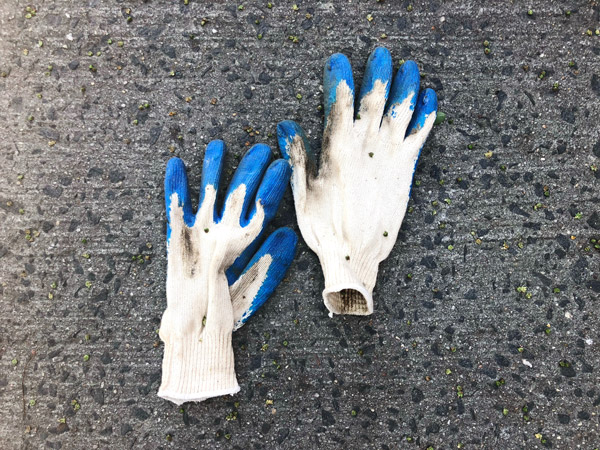
Litter comes in all shapes and sizes. You can expect to encounter all kinds of plastic, foam, cardboard, cigarettes, cans, and even appliances and grocery carts. Refer to the safety guidelines in the Clean up section for proper handling tips. The two most important cleaning supplies you will want to have are gloves and bags. Technically, any large container can be used to store collected litter, but bags make waste disposal easier.
Gloves: If picking up litter by hand, avoid wearing medical (“latex”) gloves. The rubber gloves you use to clean your house are not suitable for the work you will be doing either. We find that gardening or work gloves work best for picking up litter—and they’re reusable! “Heavy duty” gloves are even better, but they are not required. A good rule of thumb: If your gloves can protect your hands from splinters and thorns, they will be fine for a cleanup.
Bags: Standard 13-gallon trash bags will do; they do not need to be the thick or “heavy duty” kind but they should not be too thin, either. We do not recommend plastic grocery bags. Instead, opt for bags made of recycled materials. Composting bags will not work because some of the stuff you will be filling them with won’t biodegrade. Use these for food waste and lawn care instead! Check out this article for some ideas on bags. We recommend plant-based biodegradable trash bags.
OTHER RECOMMENDED SUPPLIES
First aid kit
Snacks & water
Grabbers
Rakes
Shovels
Buckets
Safety vests
Waterproof boots
Hazard tape
![]() Volunteers are asked to bring their own supplies if they have them—a pair of gloves, two or three bags, and a reusable water bottle are a good minimum. Bringing extra gloves and bags, or snacks to share, is encouraged!
Volunteers are asked to bring their own supplies if they have them—a pair of gloves, two or three bags, and a reusable water bottle are a good minimum. Bringing extra gloves and bags, or snacks to share, is encouraged!
If you live in Minneapolis, you can check out this page for litter cleanup supplies. If you are in St. Paul, you can additionally register for the Come Clean program to receive supplies.
REQUESTING SUPPLIES FROM A STORE
Inviting a store to join your effort is a great community builder! Your local hardware or grocery store may be willing to give you gloves, bags, or other supplies for free or at a discount.
Call, email, or visit the manager of the store and introduce yourself as a member of the community or affiliated with [your organization]. Invite them to participate in your cleanup by donating the supplies and promoting the cleanup effort. Explain that you and your volunteers are getting ready to pick up litter at [cleanup location] on [cleanup date] and need [supplies needed]. Building community involvement increases your impact!
Reach out to Freshwater if you need help sourcing supplies!
6. CONFIRM CLEANUP

You are almost ready for your cleanup! Five to seven days prior, check the weather forecast and put the cleanup on stand-by if the weather looks unfavorable. If necessary, cancel three to five days prior. Send out a reminder to volunteers to dress for the weather, pack supplies, bring water (preferably reusable bottles). Also include time and location, as well as directions to a meet-up spot (e.g. the southwest corner of Lot A).
![]() Use this toolkit during your cleanup! The next sections contain guidelines for cleaning, waste disposal, and safety.
Use this toolkit during your cleanup! The next sections contain guidelines for cleaning, waste disposal, and safety.
1. MEET AT SITE
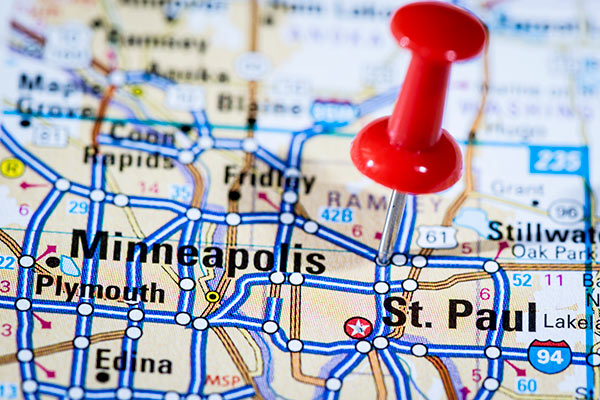
The coordinator(s) are advised to arrive at the cleanup site 10–15 minutes early to “set up shop.” Wait at the designated meetup spot. When most volunteers have arrived, the coordinator(s) can give a brief welcome and go over safety guidelines and expectations. Welcome questions at any point during the cleanup.
WELCOME & INSTRUCTIONS
- The coordinator(s), collections manager, reporter ... are… (introductions)
- Everyone is appreciated just for showing up and showing interest.
- Our work will help restore and protect the environment.
- We are here to learn and have fun!
- Pick up what you can—anything helps!
- Keep trash and recyclables separate—we’ll sort recyclables at the end.
- Working together is encouraged, but not required.
- We will be cleaning from ______ to ______ (geographic limits) for the next ____ hour(s).
- Coordinator will remind everyone when there is 15 minutes left.
- We will meet back here (or______) when finished.
SAFETY GUIDELINES
- Children (16 and under) should always have an adult nearby
- Stay hydrated and take breaks
- Watch your step—avoid wet or loose rocks and unstable ground
- Stick to land—let the coordinator know of any items in the water
- Respect wildlife and their nesting/habitat ground
- Help each other with heavy or bulky items
- Lift at the knees and engage core muscles
- Pick up aerosol cans gently and keep the nozzle away from your face
- Avoid overfilling or compacting trash bags
- Use thick gloves or tools to pick up sharp items
- Place sharp items in lined/labeled buckets
- Leave needles and syringes—too risky
- Leave sealed drums and report them to an authority
- Avoid deep digging, especially on or near banks—they may erode
- Communicate any suspicious behavior to coordinator
![]() When in doubt, leave it out. Some pieces of litter are too tricky or risky to pick up. That's OK. If you are concerned about it, take a picture to mark the location, and report it to an authority. Check out this River Keepers video for more safety info.
When in doubt, leave it out. Some pieces of litter are too tricky or risky to pick up. That's OK. If you are concerned about it, take a picture to mark the location, and report it to an authority. Check out this River Keepers video for more safety info.
2. PICK UP LITTER
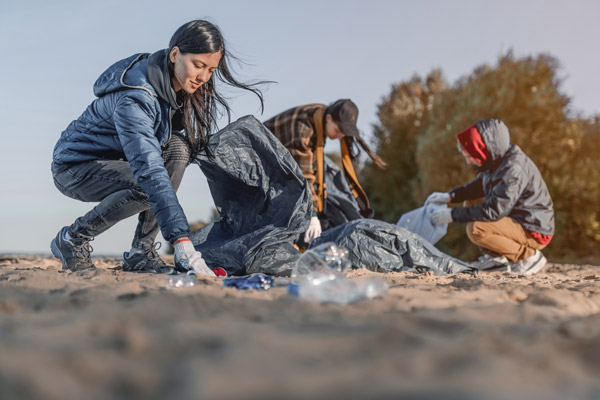
JUST PRIOR TO CLEANING
Take pictures of the site before and after your cleanup for comparison. Of course, pictures and videos can be taken throughout the entire cleanup. Assigning a reporter/photographer can be helpful with this!
WHILE YOU CLEAN
We suggest cleaning in pairs with a bag for trash and a bucket for recyclables. Pick it all up! You can sort through the litter and recyclables you collect at the end of the cleanup. It is better to dispose of anything you cannot recycle (treat it as trash), than to leave it on the ground.
Many places accept comingled recycling. Check with your city or county for local guidelines. Take a look at this waste sort guide for litter cleanups from Hennepin County for more tips.
COMMON TYPES OF LITTER
Trash: cigarettes, clothing, food wrappers
Hard plastics: gallon milk jugs, bottles & caps
Plastic bags: shopping bags, Ziplock bags
Metals: soda cans, food cans, metal bottle caps
Glass: jars, bottles, drinking glasses
Foam: takeout containers, shipping materials
3. REGROUP & RECORD DATA

When you have finished cleaning, it is time to reconvene at the meetup spot and count the bags of litter. We would also like to get an estimate of the weight of the trash you collected. Now, and in the next step, is when the collections manager can be especially helpful! Remember to report your data here.
Total bags filled
Round down to the nearest whole number. For example, if you have 20 full bags and a partially filled bag, that partial bag still matters but write 20 for bags filled.
Bags filled ___
Total pounds of trash
Assume each bag of trash weighs 10 pounds. Multiply the number of bags completely filled with trash by 10 to find the total pounds of trash you collected.
Pounds of trash ___
Total bags of recyclables
Round to the nearest whole number.
Bags filled ___
Additional data
How many people volunteered at the cleanup? ___
How many miles of shoreline were cleaned? ___
What was the weather like? ___
4. DEBRIEF & DISPOSE OF LITTER
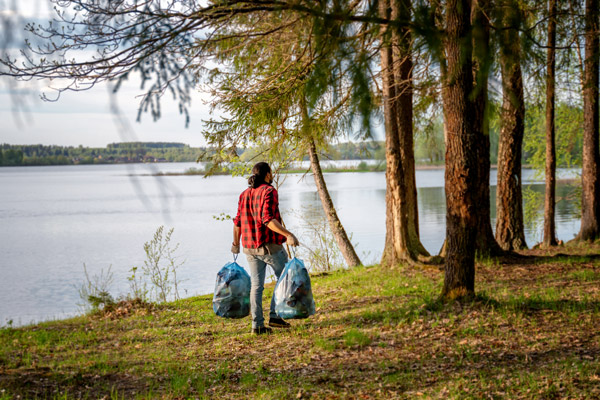
After recording data on your litter, you can dispose of the litter at on-site dumpsters or a waste/recycling facility near you. If you anticipate having a lot of trash to dispose of, you can contact your city, or plan to have volunteers haul it home or to a landfill. Before you head out, take the "after" pictures (or video) for your before and after comparison!
In Minnesota we have a strong recycling infrastructure. Minnesota's law prohibits materials collected for recycling from being trashed. However, recycling collected in trash bags and put into recycling bins cannot be properly sorted at trash facilities. Please empty your recycling bags into a comingled bin or sort them into the proper receptacles.
To recycle plastic bags, check with retail stores—many have receptacles for plastic bags in their entryways. Find drop-off locations at PlasticFilmRecycling.org or Hennepin County’s Green Disposal Guide. You can also contact Merrick, Inc. If you're interested in encouraging recycling in your area, contact the Recycling Association of Minnesota.
Once all the litter is properly disposed of, the cleaning phase is finished! Congratulations! Your participation has made our water here in Minnesota, and the waters downstream, cleaner and healthier. Celebrate and share your cleanup adventure! Capture your conversation with video or notes. Share these when you report your cleanup.
PONDERABLES
How does litter impact the aesthetic, recreational, and practical value of this area?
How did this litter arrive here?
Where would this litter go if it were not picked up?
How much of this litter is biodegradable?
How can litter pollution be prevented upstream?
STORY STARTERS
Did anything surprise you?
What was the most common kind of litter you found?
How did this experience change the way you see water?
Was anything challenging or frustrating?
Would you do this again? What would you do differently?
What is your biggest take-away?
Now that you’ve completed a cleanup, you have a neat story to share! Your notes, pictures, and videos will teach and inspire fellow community members about the role cleanups play in keeping our water clean. Data from your cleanup will be used to demonstrate the impact of cleanups in the greater story of water conservation in our region and beyond.
If this was your first cleanup, thank you! Consider adopting your shoreline for a few years. Cleaning up in the spring after the snowmelt captures a lot of litter, and doing so in the fall keeps trash from getting buried and frozen all winter.
REPORT & SHARE YOUR CLEANUP
Submit data, pictures and videos, and feedback on our reporting form. Share your story on social media too, and use #AdoptARiver!
![]() You're part of the Adopt a River community—stay connected! Check out the Additional resources section below for more ways to care for water.
You're part of the Adopt a River community—stay connected! Check out the Additional resources section below for more ways to care for water.
GLOSSARY
Adoption
A commitment to clean a body of water for a certain amount of time
Floatable
Litter that floats on the surface of water (e.g. plastic bottles)
Riparian zone
Narrow strips of land bordering bodies of water
Similar: shoreline
Stormwater
Excess water (from rainfall or snowmelt) that flows into drains and sewers, then into waterways
Similar: runoff
Surface water
Water that remains above ground; rivers, streams, creeks, lakes, ponds, wetlands, oceans, etc.
Pollution
Products and by-products of industrial, commercial, and residential activities which lower the health or quality of natural resources (e.g. surface water)
Watershed
An area of land in which surface water flows to the same place (e.g. a river)
Similar: drainage basin
HELPFUL GUIDES
Recycling—a Hennepin County guide
Recycling—accepted materials, St. Paul
Recycling—accepted materials, Minneapolis
FURTHER READING
Can Beach Cleans Do More Than Clean-Up Litter?
EXPLORE & DISCOVER
Minnesota Water Stewards Program
STAY CONNECTED
DOWNLOAD VOLUNTEER SIGNUP FORM (PDF)
Curious about the water cycle?
If you have a few minutes, this video will give you more info on the water cycle and watersheds.
